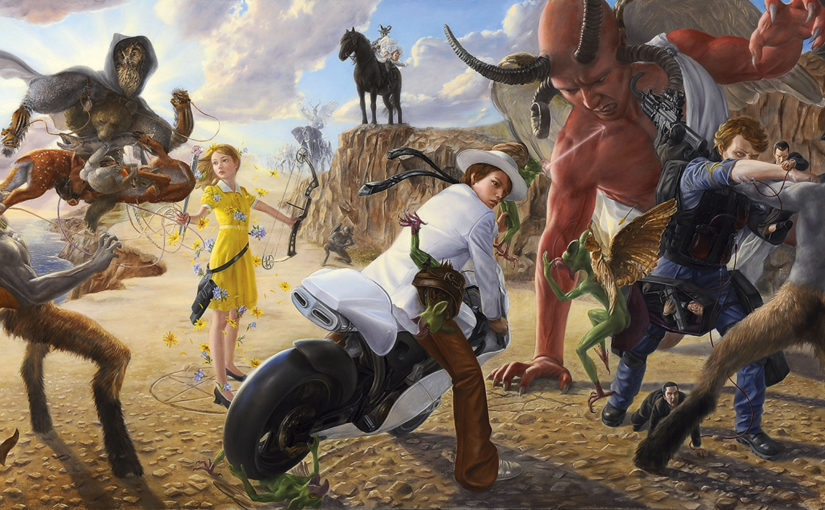The works of Tokuhiro Kawai always conjure whimsical and phantasmical stories of the likes of the Aesop and Anderson, the Grimm brothers’ fairytales. Each of his painting entails a particular story that draws viewers to its details and its numerous fascinating characters. Characters which encompass from within so vivaciously and vividly.
Kawai’s attempt to reinvigorate Renaissance style of painterly technique by imbuing myth, legend and fantasy has defined a unique sense of visual style. This style is both intriguing and refreshing in the field of Japanese contemporary art.
Each of Kawai’s painting is the blackboard to his imaginary filmstrip that allows his liberal expression to be realised into a magnificent vista that arouses viewer with curiosity and delight… not to forget the natural Japanese love of cats.
Tokuhiro Kawai is known for paintings that both recall and satirize scenes from mythology. Yet, as his statement with Gallery Gyokuei reminds us, “The history of pictorial expression is history of reproduction.”
In recent years, Kawai has specifically garnered popularity for the motif of felines donned in the garb of royalty.
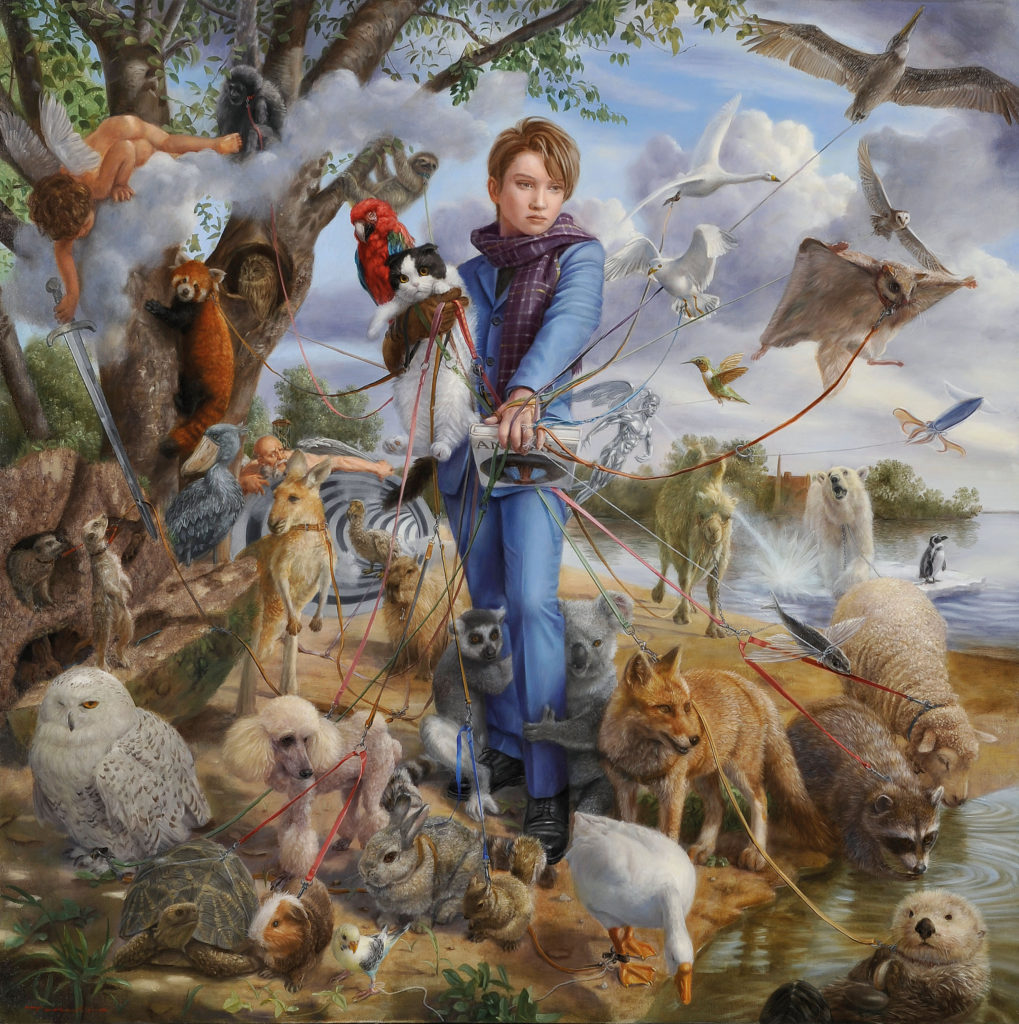
Tokuhiro Kawai (1971-present, Japanese) Tokuhiro Kawai (1971- present, Japanese) is a surrealist contemporary artist who weaves stories into his art. Sometimes relying on fantasy and magic, his works ignore gravity and perspective, stimulating thought and imagination with vivid colors. Kawai’s “regal” cats are whimsical. - Tokuhiro Kawai (1971-present, Japanese) - The Great Cat
“After the modern period, art expression has shifted its theme to personal lives and the role of storytelling is gradually passed over to literatures and films. Gyokuei says.
“Upon this, Kawai approaches to work on the now fragile bond between story and picture to bring the two into reunion. Since gods and faith are less related to our modern society, Kawai complements the theme with his own imagination.”
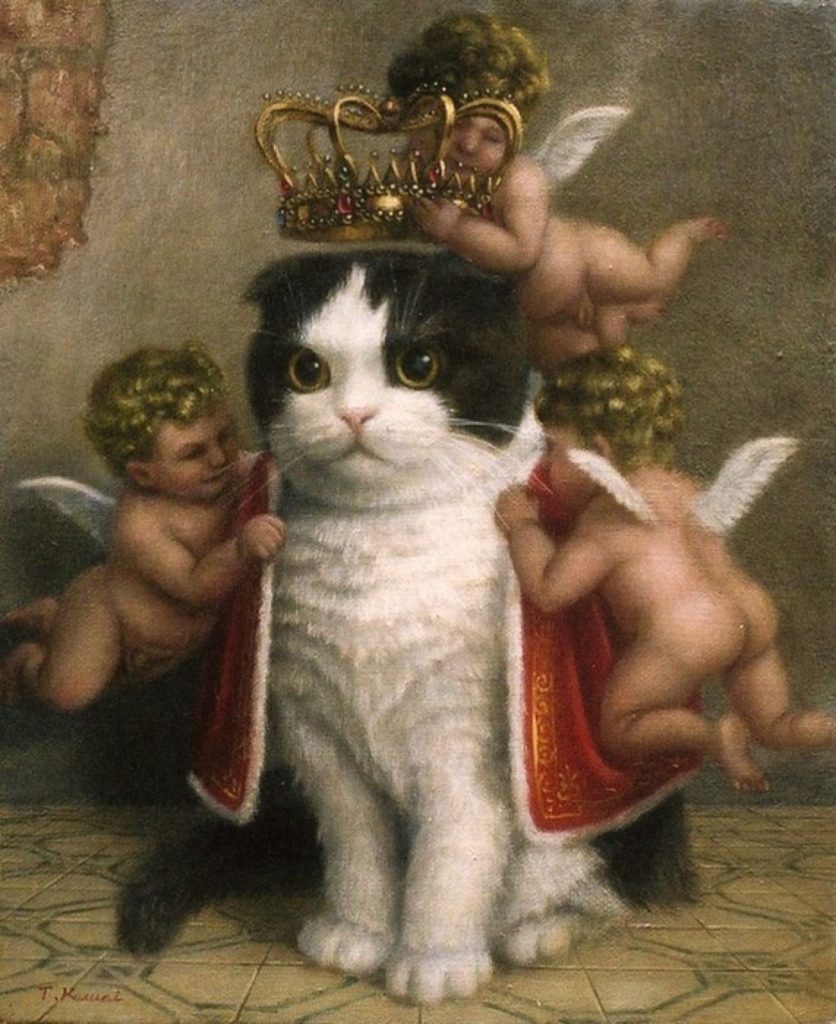
Born in 1971 in Tokyo, Tokuhiro Kawai graduated in 1995 from the oil paintings department at Tokyo National University of Fine Arts and Music, and in 1997 he graduated with a master’s degree from the same university.
He has held several solo exhibitions in Japan and a group exhibition at the Mori Art Museum in 1997, where he was an award recipient, and at Setsuryosya Firenze in 1999.
In 2006 he took part at a group exhibition at Kabutoya Gallery, Tokyo, as well as being involved in numerous exhibitions at Art Fair Tokyo since 2008.
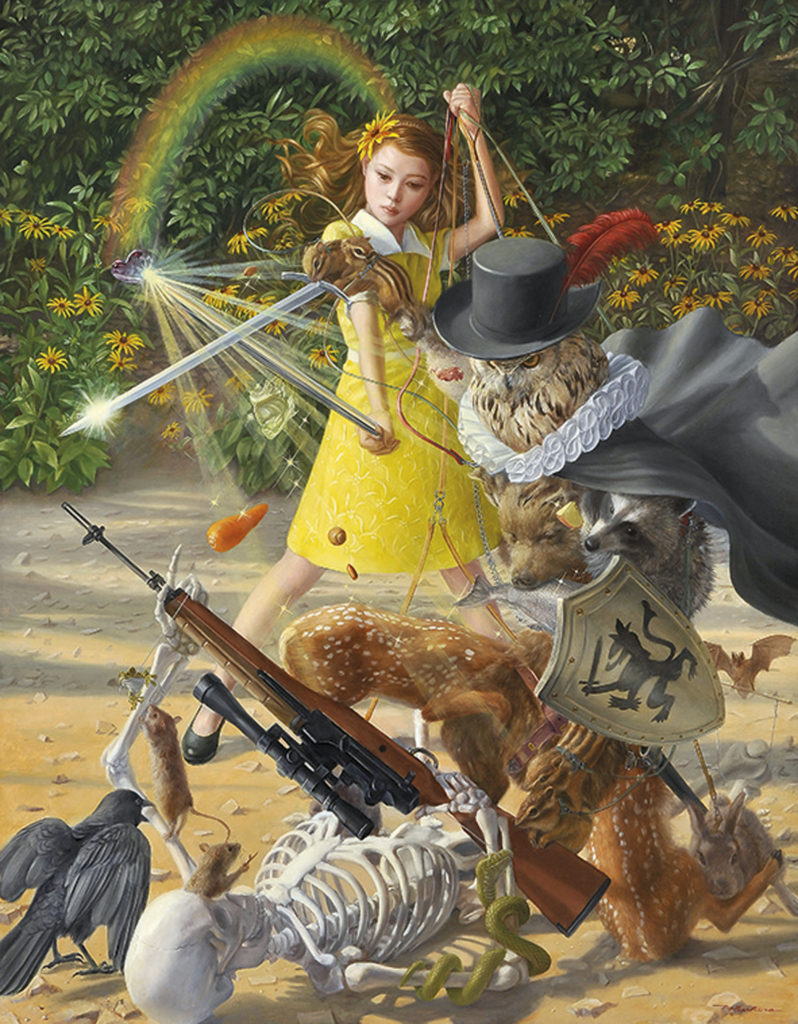
The works of Tokuhiro Kawai always conjure whimsical and phantasmical stories of the likes of the Aesop and Anderson, the Grimm brothers’ fairy. Each of his painting entails a particular story that draws viewers to its details and its numerous fascinating characters, which encompass from within so vivaciously and vividly.
In Symbiotic Relationship – Automatic Duel (Lot 557) Kawai’s floating angels behold the younglings lopsided in the sky, with the younglings’ swords closely opposed at each other. In which this composition have a nuanced affiliation with the angelic wall mural of The Creation of Adam at the Sistine Chapel from the Renaissance.
Kawai’s attempt to reinvigorate Renaissance style of painterly technique by imbuing myth, legend and fantasy has defined a unique sense of visual style that is both intriguing and refreshing in the field of Japanese contemporary art.
Each of Kawai’s painting is the blackboard to his imaginary filmstrip that allows his liberal expression to be realised into a magnificent vista that arouses viewer with curiosity and delight.
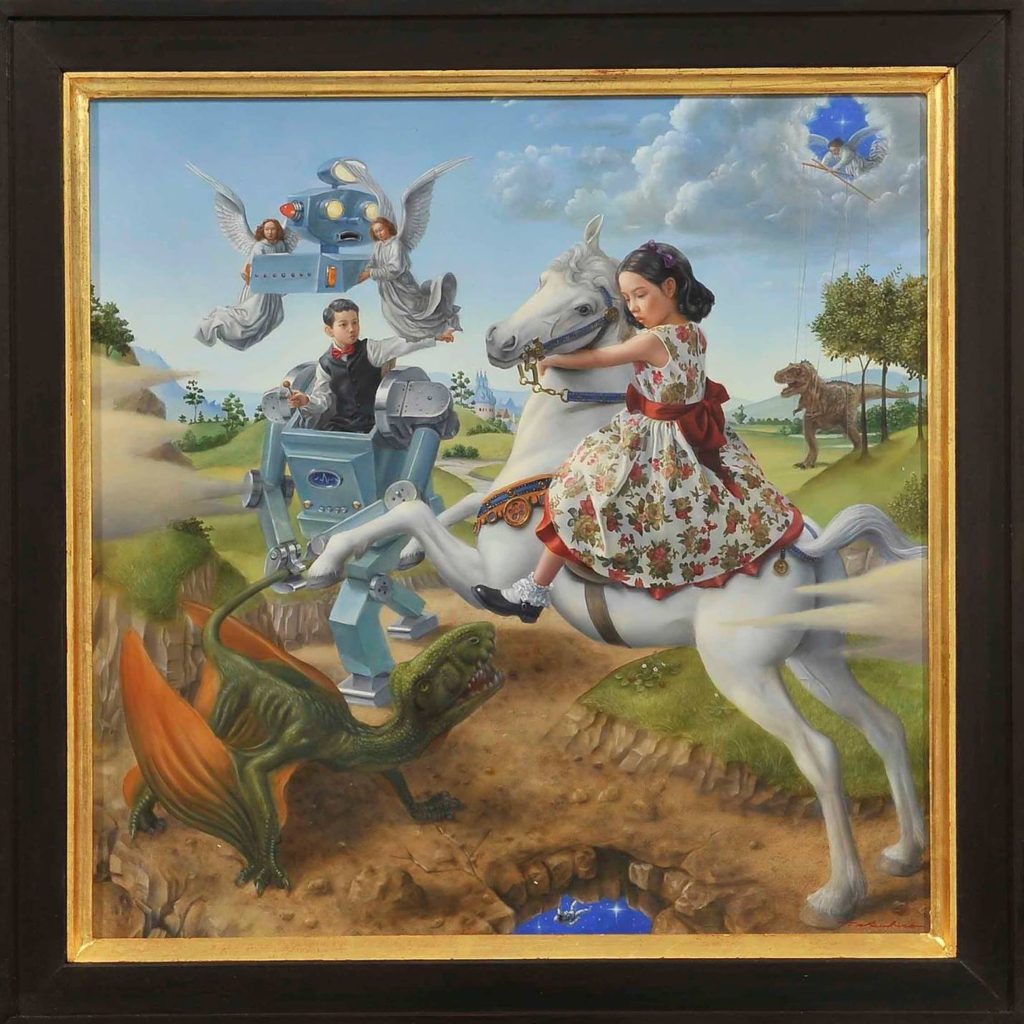
Kawai has a particular gift for painting animals and many of his compositions are filled from top to bottom with flamingos, foxes, owls, ammonites, and pelicans.
Cats seem to be his favorite and they are pictured as conquerors, tyrants, and gods.
In one of his pictures a feisty cat has killed an angel like it was a songbird and is holding the limp corpse in his fangs while standing like a stylite atop a classical column.
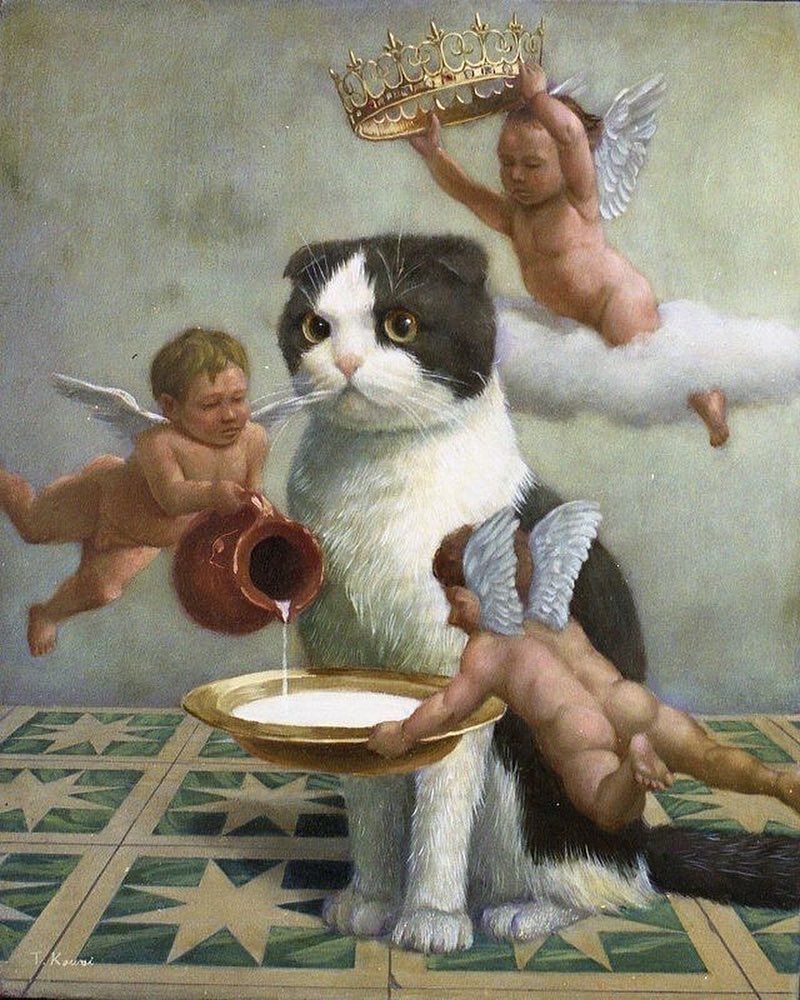
Tokuhiro Kawai is a Japanese artist from Tokyo born in 1971. The works of Tokuhiro Kawai is always coloured with beautiful stories. Ignoring the principles of physics such as gravity and perspective, idealized characters appear inside the picture, creating depth and expression to the view of his world.
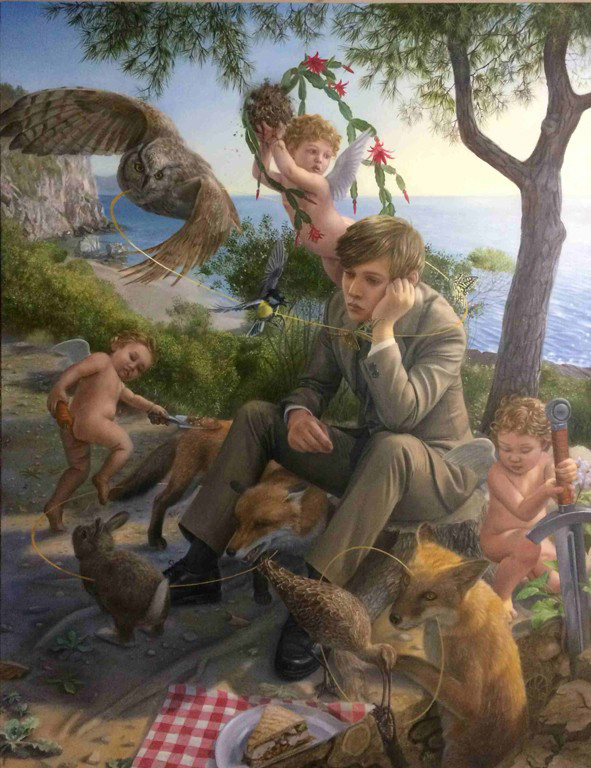
Tokuhiro Kawai is known for paintings that both recall and satirize scenes from mythology. Yet, as his statement with Gallery Gyokuei reminds us, “The history of pictorial expression is history of reproduction.”
In recent years, Kawai has specifically garnered popularity for the motif of felines…
The cultural depiction of cats and their relationship to humans is old and stretches back over 9,500 years. Cats are featured in the history of many nations, are the subject of legend and are a favorite subject of artists and writers.

Cats in Asian art have been a part of Chinese, Japanese and Korean art for centuries and are still prominent subjects of contemporary artists.
The Chinese cat goddess Li Shou was worshipped and adored, and likewise, the Japanese paid tribute to the Maneneko who is said to have saved the life of a Samurai warrior. Rooted deep in myth, cats in Asian art became an icon for Chinese and Japanese as well as other Asian cultures.
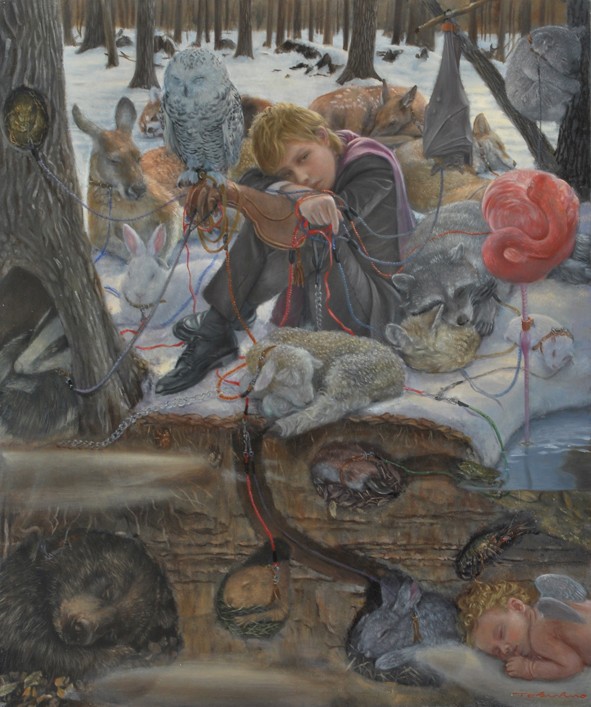
Owned only by the elite few in Japan, early scrolls show cats on leashes and living luxurious lives indoors.
In contrast, in China cats were depicted as hunters. In the Edo period (1603-1868), Japan was at peace and turned its attention to Ukiyo-e art and culture. Ukiyo-e woodblock prints made art available for the masses, and the merchant class was the first to purchase such prints.

These prints depicted cats going about their natural cat behavior: playing, sleeping and cleaning themselves. Human forms soon became cats that were often caricatures that professed some social commentary.
In the mid-19th century Japanese Kabuki actors were portrayed by cats, as it was against the law to display actual pictures of the real actors and courtesans. Because of cats’ viciousness, cat monsters appeared in art and in literature as Bakenekos. Many Asian artists have portrayed the cat through history as pampered pets, hunters, ghosts, monsters or spirits.
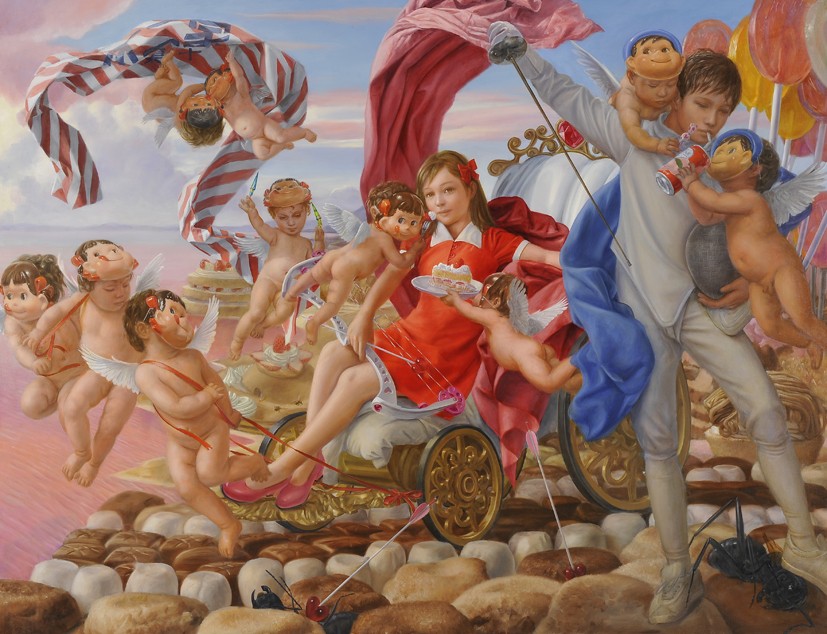
Something to look forward to in any trip is a contact with the local animals. Japanese people have lived with cats for ages and because of this history there are places in Japan that are a must-see for all cat-lovers.
‘Cat Cafés’ have become increasingly popular, and the wide variety of cat-themed merchandise available in Japan will surely appeal to the cat-lover in you.
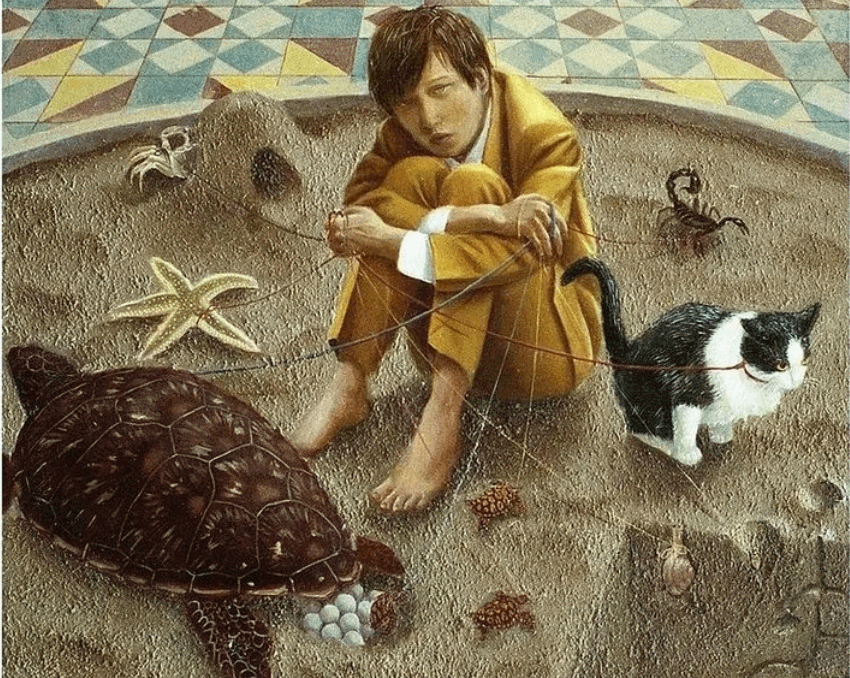
Japanese people have had a long relationship with cats. More than 1000 years ago, people in the upper class were already living with cats. Common people also started having pet cats at home several hundred years ago and Japanese people have been involved with cats in a variety of ways since then.
There are shrines that worship cats as gods across Japan and cats have also played a part in folk beliefs through the ages.
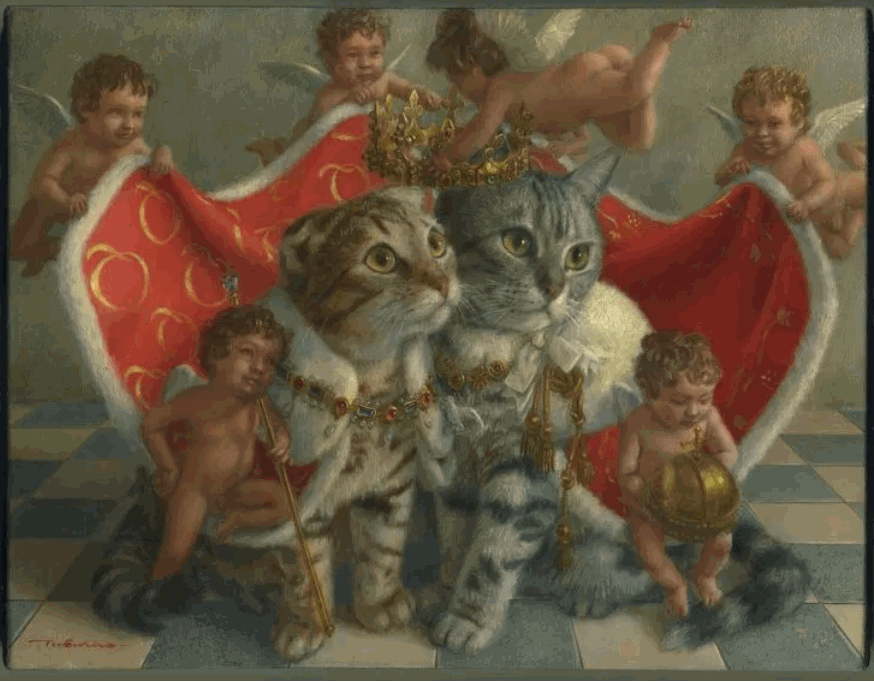
The extent to which Japanese people have been involved with cats is evident from the volume of artworks that depict cats as the main subject.
In the Edo period (1603-1868), Ukiyoe virtuosos Hiroshige Utagawa and Kuniyoshi Utagawa painted cats, and in the Meiji period (1868-1912), the great novelist Soseki Natsume wrote the novel “I Am a Cat”, which became a famous masterpiece of Japanese literature.
Even nowadays you can find examples, such as the famous character “Hello Kitty” the cute anthropomorphic cat, and “Krocchi” a stray cat character that has recently started to become popular. Cats have been loved by Japanese people through the ages.
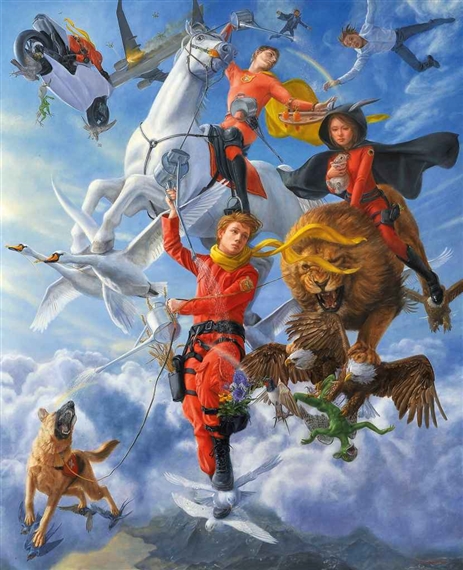
Places that show traces of the relationship between cats and people are scattered throughout Japan.
Tashirojima Island in Ishinomaki City located east of Sendai City is known as the ‘Cat Island’. Cats come to welcome the boats at the port. Many cats wait patiently around the fishing port for fishermen to return.
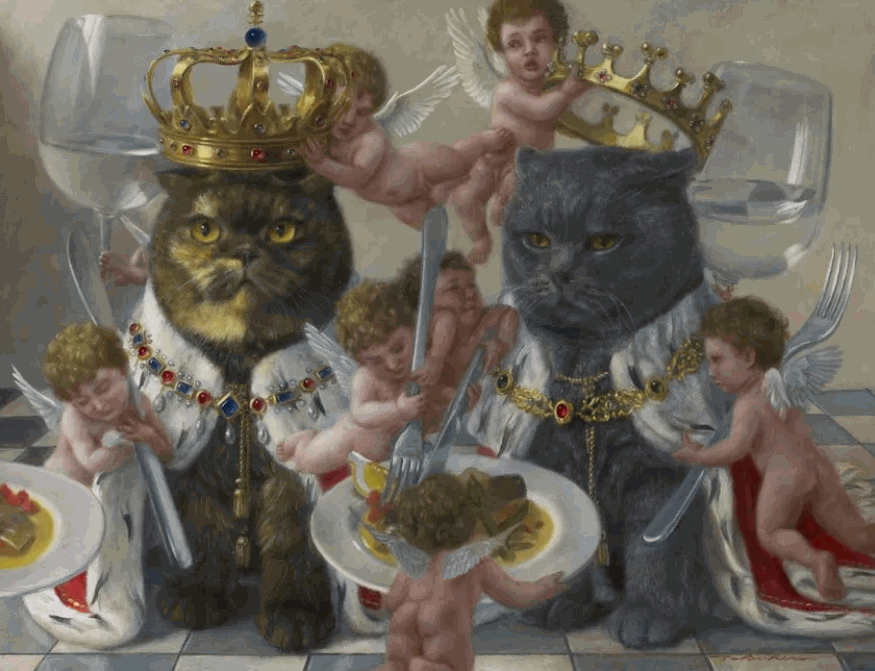
Neko-jinja or the cat shrine is located in the central area of the island and it enshrines a “cat god” in hope of a good catch and safety of the fishermen. Cats have been worshiped as gods for several hundred years when people began forecasting the outcome of fishing based on cats’ behavior.
Tashirojima Island was damaged by the Great East Japan Earthquake and tsunami in 2011, but many of the cats survived, evacuating to the area around Neko-jinja.
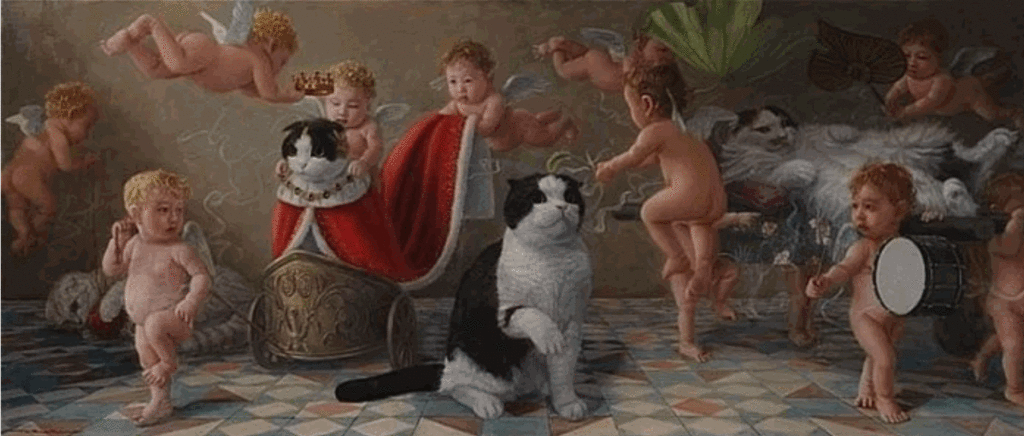
Aoshima Island in Shikoku area is also known as a cat island. The catch-phrase of this island is “15 residents and 100 cats, the cat paradise”.
They say that 10 years ago when the population of the island went below 50, the number of cats started to increase. The biggest appeal of Aoshima Island is that you can have an extremely close contact with cats. The island has recently become increasingly popular as a tourist spot, especially among cat lovers.
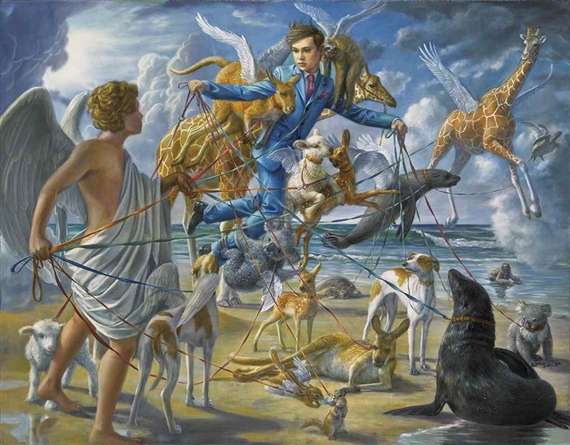
Day trips to the island are recommended since there are no accommodation or restaurants in Aoshima.
There is a passenger boat which makes the 45-minute ride twice a day to Aoshima from Nagahama port in Ozu City, Ehime prefecture located at the west end of Shikoku island. There is a limit to the number of passengers since the boat is used for the islanders’ daily use and therefore there is a chance you may not be able to board.
There are also no stores or vending machines on the island, so please make sure you take food and drinks when you visit.
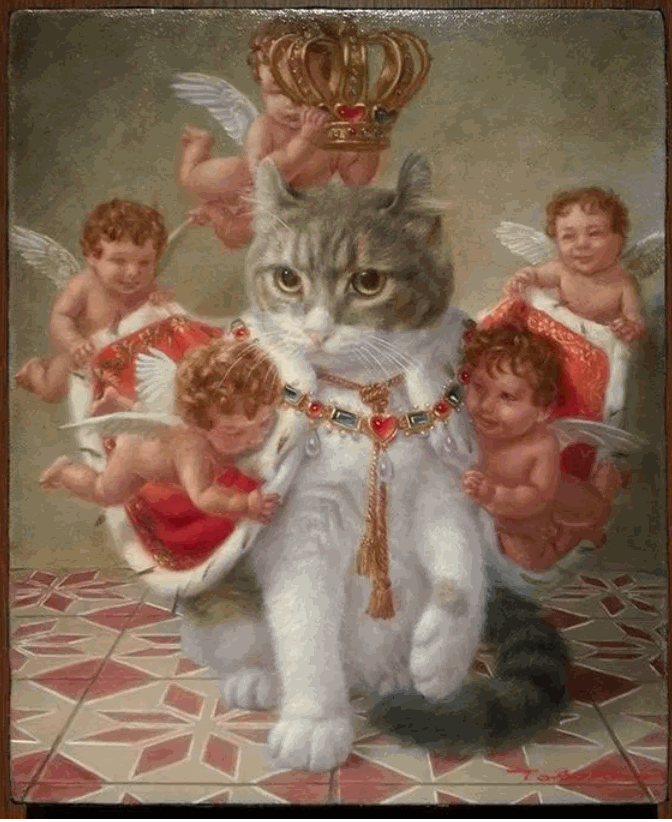
“Of course, you can also see cats in the city. In Yanaka, a cat town in Tokyo reasonably close to Ueno Park, you can see cats living freely in the city.
You can feel the old atmosphere of Japan in Yanaka Ginza, a shopping street that has kept their old streets and atmosphere. The cats living there also add to the view of the town. Shopping there is also a fun experience for cat-lovers because Yanaka Ginza has many shops selling cat-themed goods.”
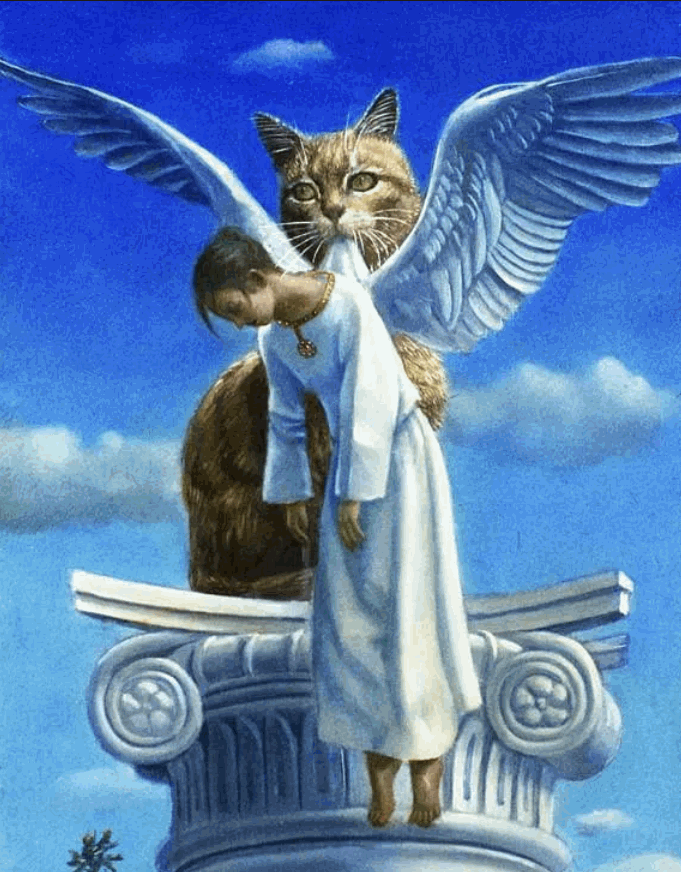
“Nyankodo” in Jinbocho, approximately 10-minute train ride away from Tokyo Station, is a book store that collects only cat-themed books.
They carry books related to cats published all over the world including photo books, literature, picture books, story books and comics. They also have books on Kuniyoshi Utagawa, a world-famous Ukiyoe painter and a photo collection of Mitsuaki Iwago, a wildlife photographer. You will surely find your favorite book here.
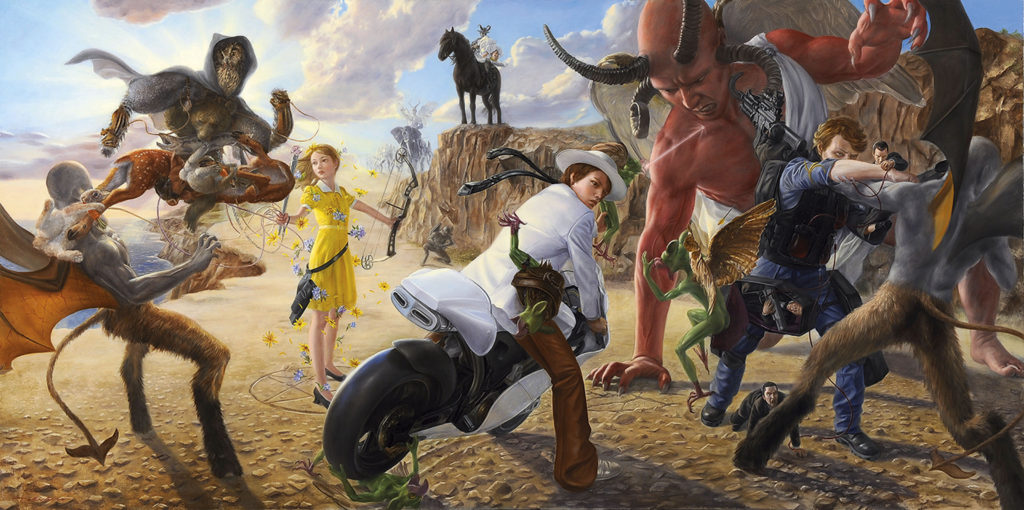
“Maneki-neko”, the beckoning or welcoming cat, is best known in Japan as a lucky charm said to bring business success. Cats used to be a lucky charm in the silk industry long ago as they get rid of crops eating rats and silkworms.
They became popular as a lucky charm to increase business. It is believed that a cat with a beckoning paw has the power to bring in more people.
According to a legend, Gotokuji Temple, located approximately 10-minutes from Gotokuji Station on the Odakyu Line in Tokyo, is the birthplace of Maneki-neko. Enshrined on one corner of the temple are a number of Maneki-neko that were donated by those whose wishes came true. There are several kinds of Maneki-neko, ranging from the small ones that cost several hundred yen to big ones that cost as much as 5,000 yen. This is a perfect souvenir for your family and friends. I bet you can almost see the smile on their faces now!
Movies that Inspired Me
Here are some movies that I consider noteworthy and worth a view. Enjoy.




Stories that Inspired Me
Here are reprints in full text of stories that inspired me, but that are nearly impossible to find in China. I place them here as sort of a personal library that I can use for inspiration. The reader is welcome to come and enjoy a read or two as well.









































My Poetry

Art that Moves Me





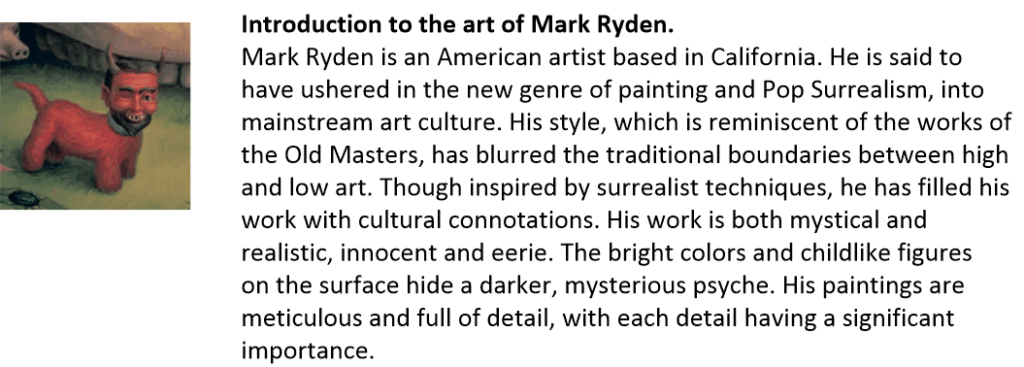

Articles & Links
You’ll not find any big banners or popups here talking about cookies and privacy notices. There are no ads on this site (aside from the hosting ads – a necessary evil). Functionally and fundamentally, I just don’t make money off of this blog. It is NOT monetized. Finally, I don’t track you because I just don’t care to.
- You can start reading the articles by going HERE.
- You can visit the Index Page HERE to explore by article subject.
- You can also ask the author some questions. You can go HERE to find out how to go about this.
- You can find out more about the author HERE.
- If you have concerns or complaints, you can go HERE.
- If you want to make a donation, you can go HERE.

